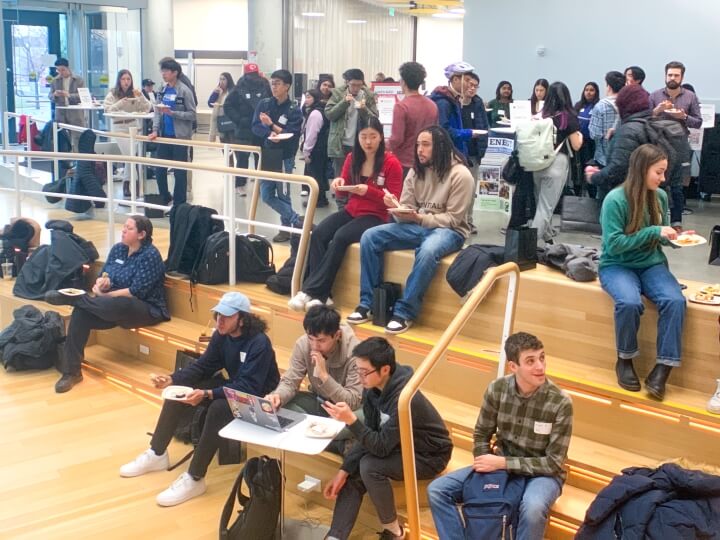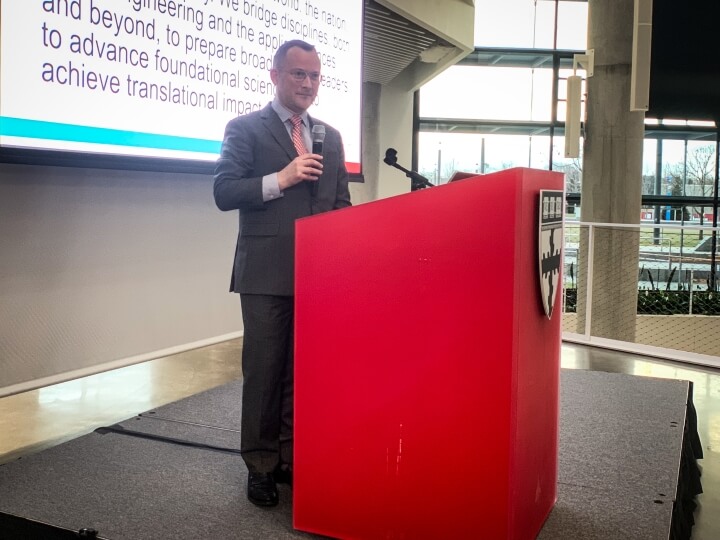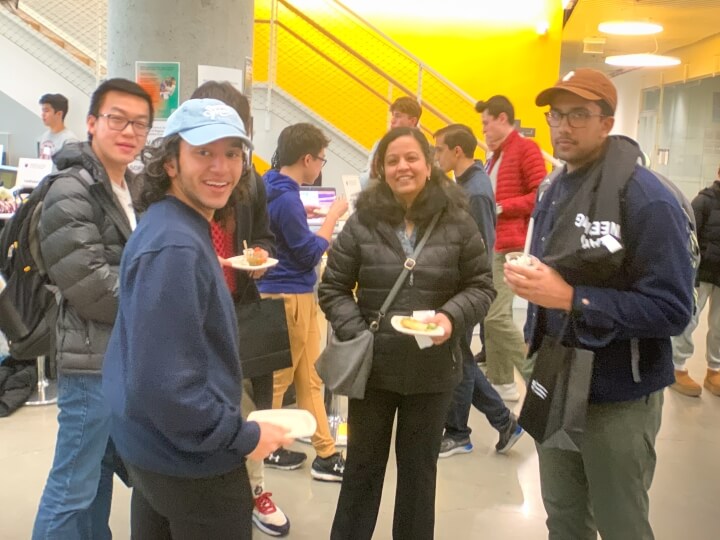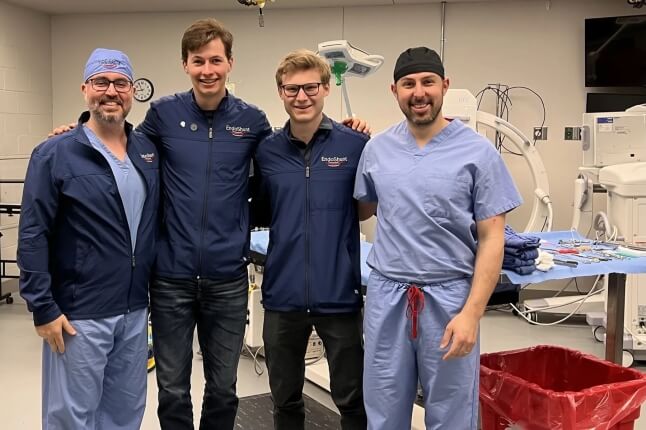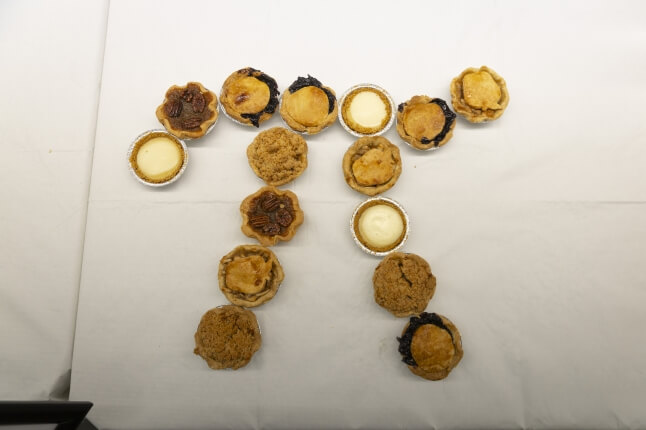News
Members of the SEAS Class of 2026 gather for Convocation in the Science and Engineering Complex (Matt Goisman/SEAS)
Davina Komaravalli chose mechanical engineering to pursue her passion for aerodynamics and motorsports. Jerry Li picked bioengineering so he could be part of the ongoing biotech revolution. Sahar Maisha decided computer science would give her the skills to build things the world needs.
“There’s a lot of flexibility with computer science to create things that can help society and the world,” said Rana Albaadani, who’s dual concentrating in computer science and the history of science. “With history of science, I’ll learn the background and ethics of the field, so that goes hand in hand.”
Whatever their individual motivations, all four second-year students are now part of the 427-student class of 2026 at the Harvard John A. Paulson School of Engineering and Applied Sciences (SEAS). SEAS Dean David Parkes welcomed the newest members of the SEAS community at a Convocation event at the Science and Engineering Complex.
“You’re all concentrating in engineering and applied sciences because you believe, like we do, that engineering is the future, and that it’s through engineering that understands societal challenges that we can change the world for the better,” said Parkes, presiding over his first Convocation as dean. “I want to encourage all of you to take advantage of the opportunities ahead of you. Take advantage of everything that’s available on this wonderful campus, be a friend of SEAS and find a way to contribute to our community. I think you’ll find that the more you put into SEAS, the more you’ll get back.”
The Class of 2026 is the second-largest in school history, surpassed only by a Class of 2025 composed in part of COVID-deferred students from the previous year. The most popular concentrations remain computer science, with 44 percent of new students, and applied math with 33 percent. SEAS students now represent 25 percent of all Harvard College concentrators.
SEAS Dean David Parkes addresses the Class of 2026 at Convocation (Matt Goisman/SEAS)
“The reason I became enamored with applied math is how we can use modeling to represent these qualitative concepts in a more quantitative way,” said Raglan Ward. “I’m looking forward to experiencing all the things that Harvard has to offer, really experiencing all the doors that can open here at SEAS.”
With its newest group of concentrators, SEAS continues to outpace national averages in diversity. The Class of 2026 identifies as 53 percent male and 47 percent female, with 23 percent identifying as part of underrepresented minorities.
“Our values embody respect, a culture of communication, and an embrace of diversity,” Parkes said. “As the newest members of our community, we, as your faculty, dean and staff that work within the school, hope that you embrace this mission.”
Along with higher-level engineering classes, Parkes encouraged students to pursue the range of activities and resources available at SEAS. The school is home to everything from affinity-based student organizations such as the Harvard Society of Black Scientists and Engineers or the Society of Women Engineers, to hobby clubs such as the Harvard Undergraduate Automotive Society or the Undergraduate Knitting Circle. Entrepreneurial opportunities are available to students through the Harvard Grid and undergraduate research opportunities are available in a wide range of labs.
“I’m looking forward to engaging more with the network within SEAS, whether that’s faculty or the community,” Komaravalli said. “There’s a big difference between taking SEAS classes in your freshman year and being a sophomore taking higher-level classes. There’s definitely a tight-knit community here.”
SEAS students and staff chat at Convocation (Matt Goisman/SEAS)
Following Parkes’ introduction, the Class of 2026 heard from three third-year students about the specific paths they’ve taken through SEAS. Bioengineering concentrator Honor Pimentel focused on her cardiac research in the Disease Biophysics Group of Kit Parker, Tarr Family Professor of Bioengineering and Applied Physics, while applied math concentrator Matthew Andrews discussed the benefits of becoming a course teaching fellow or concentration peer advisor.
“These are really rewarding experiences, and are really the lifeblood of your favorite courses,” Andrews said. “As peer concentration advisors and teaching staff, we really want to give you the things we wish we knew. But also remember that you’ve accumulated knowledge that others might wish they have. When the moment comes around, I really encourage you to apply to join us.”
Sophia Salamanca, a third-year computer science and concentrator with a secondary in government, concluded the talks with her own varied journey through SEAS. Her three years have included studying overseas and a Research Experience for Undergraduates program at the University of Miami, her involvement with multiple academic departments, and her time as a Fellow for the SEAS Office for Diversity, Inclusion and Belonging.
“My one piece of advice is to diversify your semesters and summers as much as possible,” Salamanca said. “I implore you to maintain balance by exploring, developing and curating your hobbies.”
Cutting-edge science delivered direct to your inbox.
Join the Harvard SEAS mailing list.
Press Contact
Matt Goisman | mgoisman@g.harvard.edu
